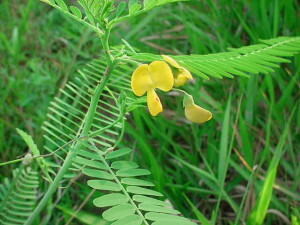The legume Sesbania bispinosa, also known as Sesbania aculeata (Willd.) Pers., is a small tree in the genus Sesbania.
The flower is the provincial flower of Phra Nakhon Si Ayutthaya Province, Thailand.
Contents
Uses
The plant has a great number of uses, including as green manure, rice straw, wood and fodder.
- It can be used like industrial hemp for rope, fish nets, sackcloth and sailcloth. Its fibers are similar to those of birch trees and show promise as a source of paper fiber.
- The foliage makes a good fodder for livestock and the beans can be fed to fowl. The plant has been also used as a famine food by people.
- Natural gum from the plant is useful as a thickening agent.
- Like other legumes, it can be planted to improve the soil via nitrogen fixation.
- It makes a good firewood.
- The beans have historically been used in poultices to treat ringworm and other skin infections.
The yellow flowers of S. aculeata are eaten as a vegetable in Southeast Asia. They are much smaller than the more popular white flowers of Sesbania grandiflora, but similar in shape. Still, they are appreciated as food in Thai and Vietnamese cuisine.
In the Thai language the flowers are called ดอกโสน (dok sanō). They are used in Thai cuisine both cooked and raw, they can also be used to make omelettes and sweets
Benefits
-
A major benefit obtained from growing Sesbania is the addition of organic matter to our desert soils. During the breakdown of organic matter by microorganisms, compounds are formed that are resistant to decomposition—such as gums, waxes, and resins. These compounds help bind together soil particles as granules, or aggregates. A well-aggregated soil tills easily, is well aerated, and has a high water infiltration rate.
Arizona desert vegetable growers can achieve increased yields, pest suppression, and reduced soil erosion and nutrient leaching by growing summer cover crops prior to planting winter crops.
Cover crops suppress pests and fix the nitrogen in legumes which enhances plant development especially in organic crop production where synthetic pesticides and nitrogen fertilizers are not permitted. Cover crops can offer similar benefits in conventionally-grown winter vegeta- bles.
Unlike other legumes, Sesbania does not need herbicide applications to be established in weedy fields and is considered an excellent cover crop in our hot Yuma climate. When planted in late spring, this crop can cover the ground in less than 4 weeks, and in 50 days Sesbania can grow over 6 feet tall and produced over 2 tons per acre of dry biomass. The nitrogen that Sesbania captures from the atmosphere is estimated to be about 100 pounds per acre.
Typically, Sesbania starts to flower in early September in the low deserts and needs to be cut or incorporated into the soil before the end of September.
The flowers of Sesbania are eaten as a vegetable in Southeast Asia, particularly in Laos. The young pods are also eaten, along with the leaves.
Cautions
- Please talk to your nutritionist
Interactions
We currently have no information for sesbania Interactions.
Other names
Sesbania aculeata, Sesbania bispinosa
References
Source: Wikipedia, https://en.wikipedia.org/wiki/Sesbania_bispinosa
Cals.arizona, https://cals.arizona.edu/fps/sites/cals.arizona.edu.fps/files/cotw/Sesbenia.pdf

